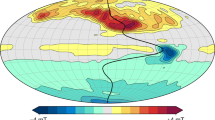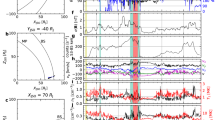Abstract
A plume of water vapour escapes from fissures crossing the south polar region of the Saturnian moon Enceladus1,2,3,4,5,6. Tidal deformation of a thin surface crust above an internal ocean could result in tensile and compressive stresses that would affect the width of the fissures7; therefore, the quantity of water vapour released at different locations in Enceladus’ eccentric orbit is a crucial measurement of tidal control of venting. Here we report observations of an occultation of a star by the plume on 24 October 2007 that revealed four high-density gas jets superimposed on the background plume. The gas jet positions coincide with those of dust jets reported elsewhere8 inside the plume. The maximum water column density in the plume is about twice the density reported earlier2. The density ratio does not agree with predictions7—we should have seen less water than was observed in 2005. The ratio of the jets’ bulk vertical velocities to their thermal velocities is 1.5 ± 0.2, which supports the hypothesis that the source of the plume is liquid water, with gas accelerated to supersonic velocity in nozzle-like channels9.
This is a preview of subscription content, access via your institution
Access options
Subscribe to this journal
Receive 51 print issues and online access
$199.00 per year
only $3.90 per issue
Buy this article
- Purchase on Springer Link
- Instant access to full article PDF
Prices may be subject to local taxes which are calculated during checkout



Similar content being viewed by others
References
Dougherty, M. K. et al. Identification of a dynamic atmosphere at Enceladus with the Cassini Magnetometer. Science 311, 1406–1409 (2006)
Hansen, C. J. et al. Enceladus’ water vapor plume. Science 311, 1423–1425 (2006)
Spahn, F. et al. Cassini dust measurements at Enceladus and implications for the origin of the E ring. Science 311, 1416–1418 (2006)
Spencer, J. R. et al. Cassini encounters Enceladus: Background and the discovery of a south polar hot spot. Science 311, 1401–1405 (2006)
Waite, J. H. et al. Cassini ion and neutral mass spectrometer: Enceladus plume composition and structure. Science 311, 1419–1422 (2006)
Porco, C. C. et al. Cassini observes the active south pole of Enceladus. Science 311, 1393–1401 (2006)
Hurford, T. A., Helfenstein, P., Hoppa, B. V., Greenberg, R. & Bills, B. Eruptions arising from tidally controlled periodic openings of rifts on Enceladus. Nature 447, 292–294 (2007)
Spitale, J. N. & Porco, C. C. Association of the jets of Enceladus with the warmest regions on its south-polar fractures. Nature 449, 695–697 (2007)
Schmidt, J., Brilliantov, N., Spahn, F. & Kempf, S. Slow dust in Enceladus’ plume from condensation and wall collisions in tiger stripe fractures. Nature 451, 685–688 (2008)
Esposito, L. W. et al. Ultraviolet imaging spectroscopy shows an active Saturnian system. Science 307, 1251–1255 (2005)
Esposito, L. W. et al. The Cassini Ultraviolet Imaging Spectrograph investigation. Space Sci. Rev. 115, 299–361 (2004)
Colwell, J. E. et al. Voyager photopolarimeter observations of Uranian ring occultations. Icarus 83, 102–125 (1990)
Esposito, L. W., Meinke, B. K., Colwell, J. E., Nicholson, P. D. & Hedman, M. M. Moonlets and clumps in Saturn’s F ring. Icarus 194, 278–289 (2008)
Tian, F., Stewart, A. I. F., Toon, O. B., Larsen, K. W. & Esposito, L. W. Monte Carlo simulations of the water vapor plumes on Enceladus. Icarus 188, 154–161 (2007)
Mota, R. et al. Water VUV electronic state spectroscopy by synchrotron radiation. Chem. Phys. Lett. 416, 152–159 (2005)
Hurford, T. A., Bills, B., Greenberg, R., Hoppa, G. V. & Helfenstein, P. How libration affects strike-slip displacement on Enceladus. Lunar Planet. Sci. Conf. XXXIX, abstr. 1826 (2008)
Kieffer, S. W. et al. A clathrate reservoir hypothesis for Enceladus’ south polar plume. Science 314, 1764–1766 (2006)
Matson, D. L., Castillo, J. C., Lunine, J. & Johnson, T. V. Enceladus’ plume: Compositional evidence for a hot interior. Icarus 187, 569–573 (2007)
Acknowledgements
We acknowledge the Cassini Navigation Team, particularly B. Buffington and Y. Hahn, who were central to the success of this observation. This work was supported by the Cassini Project at the Jet Propulsion Laboratory, California Institute of Technology, under a contract with the National Aeronautics and Space Administration.
Author Contributions Every co-author contributed a significant piece of analysis to this paper; C.J.H. was lead author of this collection of work.
Author information
Authors and Affiliations
Corresponding author
Supplementary information
Supplementary Information
This file contains Supplementary Notes and Supplementary Figure S1 with Legend. (PDF 1212 kb)
Rights and permissions
About this article
Cite this article
Hansen, C., Esposito, L., Stewart, A. et al. Water vapour jets inside the plume of gas leaving Enceladus. Nature 456, 477–479 (2008). https://doi.org/10.1038/nature07542
Received:
Accepted:
Issue Date:
DOI: https://doi.org/10.1038/nature07542
This article is cited by
-
Detection of HCN and diverse redox chemistry in the plume of Enceladus
Nature Astronomy (2023)
-
JWST molecular mapping and characterization of Enceladus’ water plume feeding its torus
Nature Astronomy (2023)
-
Exploration of Enceladus and Titan: investigating ocean worlds’ evolution and habitability in the Saturn system
Experimental Astronomy (2022)
-
Ice-Ocean Exchange Processes in the Jovian and Saturnian Satellites
Space Science Reviews (2020)
-
Key Technologies and Instrumentation for Subsurface Exploration of Ocean Worlds
Space Science Reviews (2020)
Comments
By submitting a comment you agree to abide by our Terms and Community Guidelines. If you find something abusive or that does not comply with our terms or guidelines please flag it as inappropriate.



